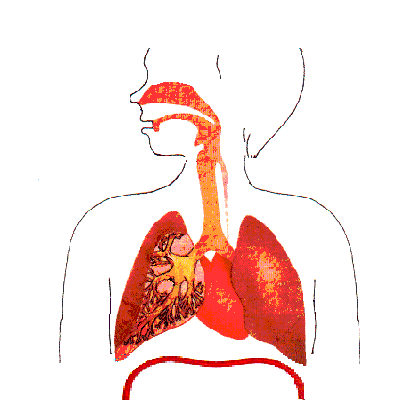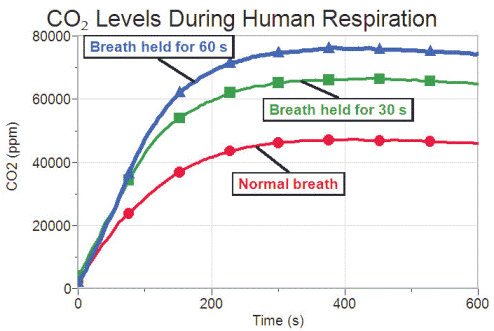Main
Definition
Mechanics
Cell respiration
|
Mechanics
 In mammals, breathing in, or inhaling, is usually an active movement, with the contraction of the diaphragm muscle. This is known as negative pressure breathing. Normally, the diaphragm's relaxed position recoiled (decreasing the thoracic volume) whereas in the contracted position it is pulled downwards (increasing the thoracic volume). This process works in conjunction with the intercostal muscles connected to the rib cage. Contraction of these muscles lifts the rib cage, thus aiding in increasing the thoracic volume. Relaxation of the diaphragm compresses the lungs, effectively decreasing their volume while increasing the pressure inside them. The intercostal muscles simultaneously relax, further decreasing the volume of the lungs. With a pathway to the mouth or nose clear, this increased pressure forces air out of the lungs. Conversely, contraction of the diaphragm increases the volume of the (partially empty) lungs, decreasing the pressure inside, which creates a partial vacuum.
In mammals, breathing in, or inhaling, is usually an active movement, with the contraction of the diaphragm muscle. This is known as negative pressure breathing. Normally, the diaphragm's relaxed position recoiled (decreasing the thoracic volume) whereas in the contracted position it is pulled downwards (increasing the thoracic volume). This process works in conjunction with the intercostal muscles connected to the rib cage. Contraction of these muscles lifts the rib cage, thus aiding in increasing the thoracic volume. Relaxation of the diaphragm compresses the lungs, effectively decreasing their volume while increasing the pressure inside them. The intercostal muscles simultaneously relax, further decreasing the volume of the lungs. With a pathway to the mouth or nose clear, this increased pressure forces air out of the lungs. Conversely, contraction of the diaphragm increases the volume of the (partially empty) lungs, decreasing the pressure inside, which creates a partial vacuum.
 Environmental air then follows its pressure gradient down to fill the lungs.
Environmental air then follows its pressure gradient down to fill the lungs.
In amphibians, the process used is positive pressure breathing. Muscles lower the floor of the oral cavity, enlarging it and drawing in air through the nostrils (which uses the same mechanics - pressure, volume, and diffusion - as a mammalian lung). With the nostrils and mouth closed, the floor of the oral cavity is forced up, which forces air down the trachea into the lungs.
At rest, breathing out, or exhaling, is a combination of passive and active processes powered by the elastic recoil of the alveoli, similar to a deflating balloon, and the contraction of the muscular body wall. The following organs are used in respiration:
- the mouth;
- the nose and nostrils;
- the pharynx; the larynx;
- the trachea;
- the bronchi and bronchioles;
- the lungs;
- the diaphragm;
- and the terminal branches of the respiratory tree, such as the alveoli.

|

 Environmental air then follows its pressure gradient down to fill the lungs.
Environmental air then follows its pressure gradient down to fill the lungs.